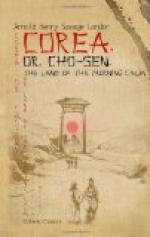[Illustration: THE BLIND BEGGAR: SEOUL]
It is only seldom that beggars are to be seen in Cho-sen, for they are not allowed to prowl about except on certain special occasions, and festivities, when the streets are simply crammed with them. It is then that the most ghastly diseases, misfortunes, accidents, and deformities are made use of and displayed before you to extract from your pockets the modest sum of a cash. I cannot say that I am easily impressed by such sights, and far less horrified, for in my lifetime it has been my luck to see so many that I have got accustomed to them; but I must confess to being on one occasion really terrified at the sight of a Corean beggar. I was sketching not very far from this stone miniature bridge on which we are supposed to be still standing, when I perceived the most ghastly object coming towards me. It looked like a human being, and it did not; but it was. As he drew nearer, I could not help shivering. He was a walking skeleton, minus toes and fingers. He was almost naked, except that he had a few rags round his loins; and the skin that hardly covered his bones was a mass of sores. His head was so deformed and his eyes so sunken that a Peruvian mummy would have been an Adonis if compared with him. Nose he had none—et ca passe—for in Seoul it is a blessing not to have one; and where his mouth should have been there was a huge gap, his lower jaw being altogether missing. A few locks of long hair in patches on his skull, blown by the wind, completed a worthy frame for this most unprepossessing head.
Oh, what a hideous sight! He hopped along a step or two at a time on his bony legs and toeless feet, keeping his balance with a long crutch, which he held under his arm, and he had a sort of wooden cup attached by a string to his neck, into which people might throw their charities. “He is a leper,” a Corean, who stood by my side and had noticed the ever-increasing expression of horror on my face, informed me.




